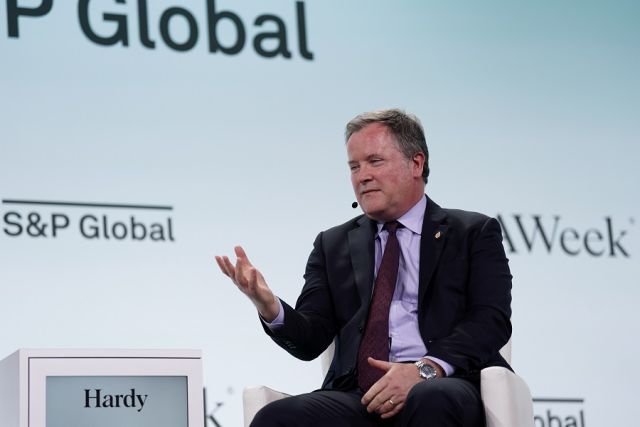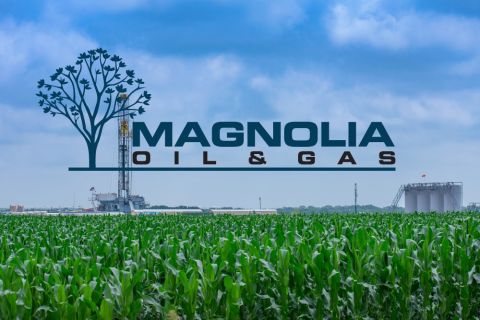
Russell Hardy, CEO of Vitol, sees peak oil demand in the early 2030s because of the complexities of the energy transition, he said at CERAWeek by S&P Global. (Source: CERAWeek by S&P Global)
Vitol forecasts show global crude demand peaking early next decade, but the global commodities trader still sees value in owning upstream production.
Russell Hardy, CEO of Vitol, the world’s largest oil trader, said the firm is projecting crude oil demand to flatten out and peak in the early 2030s.
“We are generally pushing [peak demand] out a little bit further at the moment because of some of the complexities of energy transition,” Hardy said at the CERAWeek by S&P Global conference in Houston.
“Getting projects done, getting grids decarbonized is taking longer than probably most people anticipated,” he said.
Outside of the trading realm, Vitol has journeyed into buying its own energy assets over the past decade, including upstream, downstream, refining and power generation assets.
The U.S. has attracted a significant amount of Vitol’s upstream investment. The firm backed two upstream E&P companies in the Permian Basin: Vencer Energy in the Midland Basin and VTX Energy Partners in the southern Delaware Basin.
Last year, Vencer agreed to a $2.11 billion cash-and-stock buyout by Colorado-based public Civitas Resources.
Vencer, funded by Vitol in 2020, owned interests in about 44,000 net acres across Texas in Midland, Martin, Upton, Glasscock and Reagan counties—some of the cheapest areas to drill in the Midland Basin.
VTX Energy, the second Permian producer backed by Vitol, has consolidated a sizable footprint in the southern Delaware Basin since it was funded in 2022.
And after selling Vencer to Civitas, Vitol is considering adding assets to its portfolio through a new upstream platform.
Hardy said Vitol has found that connecting its upstream and other energy-related investments to its trading business “has added value in different ways for different sectors.”
The firm also aims to take advantage of the disparity between values in public and private markets.
“Ultimately, investment in our space is limited in comparison to what it was a few years ago,” Hardy said. “That limited appetite for investment in the hydrocarbon space is effectively weighing on multiples."
Exxon Mobil is known as one of the largest oil and gas producers around the world, but the U.S. supermajor is working to grow its own trading capabilities.
Liam Mallon, president of Exxon Mobil Upstream Co., said Exxon’s trading capabilities were wrapped up in the upstream business up until about a year ago. Exxon realized it could leverage insights from its global portfolio of energy assets to expand its own commodity trading capabilities, Mallon said at CERAWeek.

“In fact, we were told that many times — that [Exxon is] in the most unique position to leverage insights better than anybody else,” Mallon said on the panel.
“We’re hiring a significant amount of new people,” he said.
The expanding reach of a juggernaut like Exxon’s into the trading realm doesn’t scare Vitol, however.
“There’s plenty of space for everybody,” Hardy said. “Obviously it’s getting more competitive.”
RELATED: Vitol: Oil Demand Peaks in 2030s, Saudis to Quit Supply Cut This Year
Married in Midland
Exxon is getting deeper into trading while also getting bigger in Permian upstream production.
Exxon’s pending $64.5 billion acquisition of Permian pure-play Pioneer Natural Resources, when closed, will cement Exxon as the basin’s top producer.
Closing the Pioneer acquisition is going “basically to plan,” Mallon said, including the Federal Trade Commission’s additional requests for information about the proposed combination.
When it comes to transition planning and integration, Exxon wants the Pioneer acquisition to feel more like a marriage and less like a $60 billion player getting eaten by a $450 billion giant.
“In reality, we’re the same size in Midland, which is what we’re really acquiring,” Mallon said. “We viewed this as a merger of equals.”
After the Pioneer acquisition, Exxon’s oil and gas production is forecast to rise to nearly 7% of total U.S. output—leapfrogging from about 750,000 bbl/d to 1.3 MMbbl/d—according to an analysis by the U.S. Energy Information Administration.
Exxon plans to boost output to 4.2 MMboe/d by 2027—up roughly 10% from about 3.8 MMboe/d in 2024.
The growth will be primarily driven from gains from Exxon’s Permian Basin acreage in West Texas and New Mexico and from the company’s foothold offshore Guyana.
Mallon has been involved with Exxon’s exploration offshore Guyana since Exxon first started exploration activities in the country in 2008.
“In my 40-year career,” Mallon said, “I have never worked on anything so exciting and prolific.”
Recommended Reading
CEO: Coterra ‘Deeply Curious’ on M&A Amid E&P Consolidation Wave
2024-02-26 - Coterra Energy has yet to get in on the large-scale M&A wave sweeping across the Lower 48—but CEO Tom Jorden said Coterra is keeping an eye on acquisition opportunities.
CEO: Magnolia Hunting Giddings Bolt-ons that ‘Pack a Punch’ in ‘24
2024-02-16 - Magnolia Oil & Gas plans to boost production volumes in the single digits this year, with the majority of the growth coming from the Giddings Field.
Patterson-UTI Braces for Activity ‘Pause’ After E&P Consolidations
2024-02-19 - Patterson-UTI saw net income rebound from 2022 and CEO Andy Hendricks says the company is well positioned following a wave of E&P consolidations that may slow activity.
From Restructuring to Reinvention, Weatherford Upbeat on Upcycle
2024-02-11 - Weatherford CEO Girish Saligram charts course for growth as the company looks to enter the third year of what appears to be a long upcycle.
Endeavor Integration Brings Capital Efficiency, Durability to Diamondback
2024-02-22 - The combined Diamondback-Endeavor deal is expected to realize $3 billion in synergies and have 12 years of sub-$40/bbl breakeven inventory.





